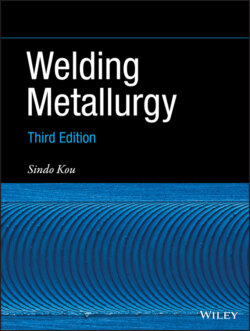Читать книгу Welding Metallurgy - Sindo Kou - Страница 48
1.4.2.3 Shielding Gas
ОглавлениеA plasma (an ionic gas) is produced during LBW, especially at high power levels, due to ionization of metal vapor by the laser beam. The plasma can absorb and scatter the laser beam and reduce the depth of penetration significantly. It is therefore necessary to remove or suppress the plasma [22]. The shielding gas for protecting the molten metal can be directed sideways to blow and deflect the plasma away from the beam path. Helium is often preferred to argon as the shielding gas for high‐power LBW because of greater penetration depth [23].
Since the ionization energy of helium (24.5 eV) is higher than that of argon (15.7 eV), helium is less likely to be ionized and become part of the plasma than argon. However, helium is lighter than air and is thus less effective in displacing air from the beam path. He‐10% Ar shielding has been found to improve penetration over pure He at high‐speed welding where a light shielding gas may be less able to displace air from the beam path [24].
